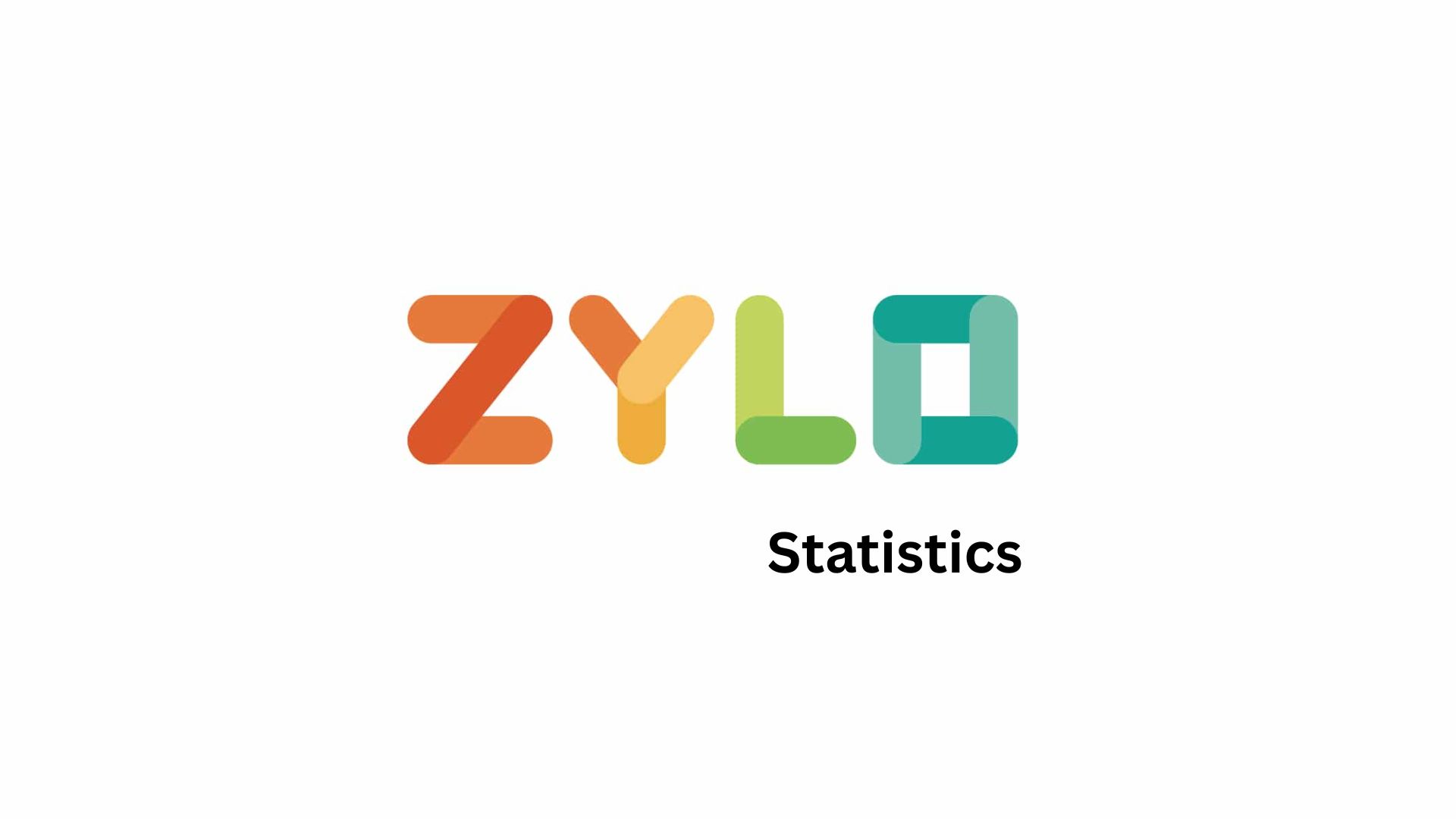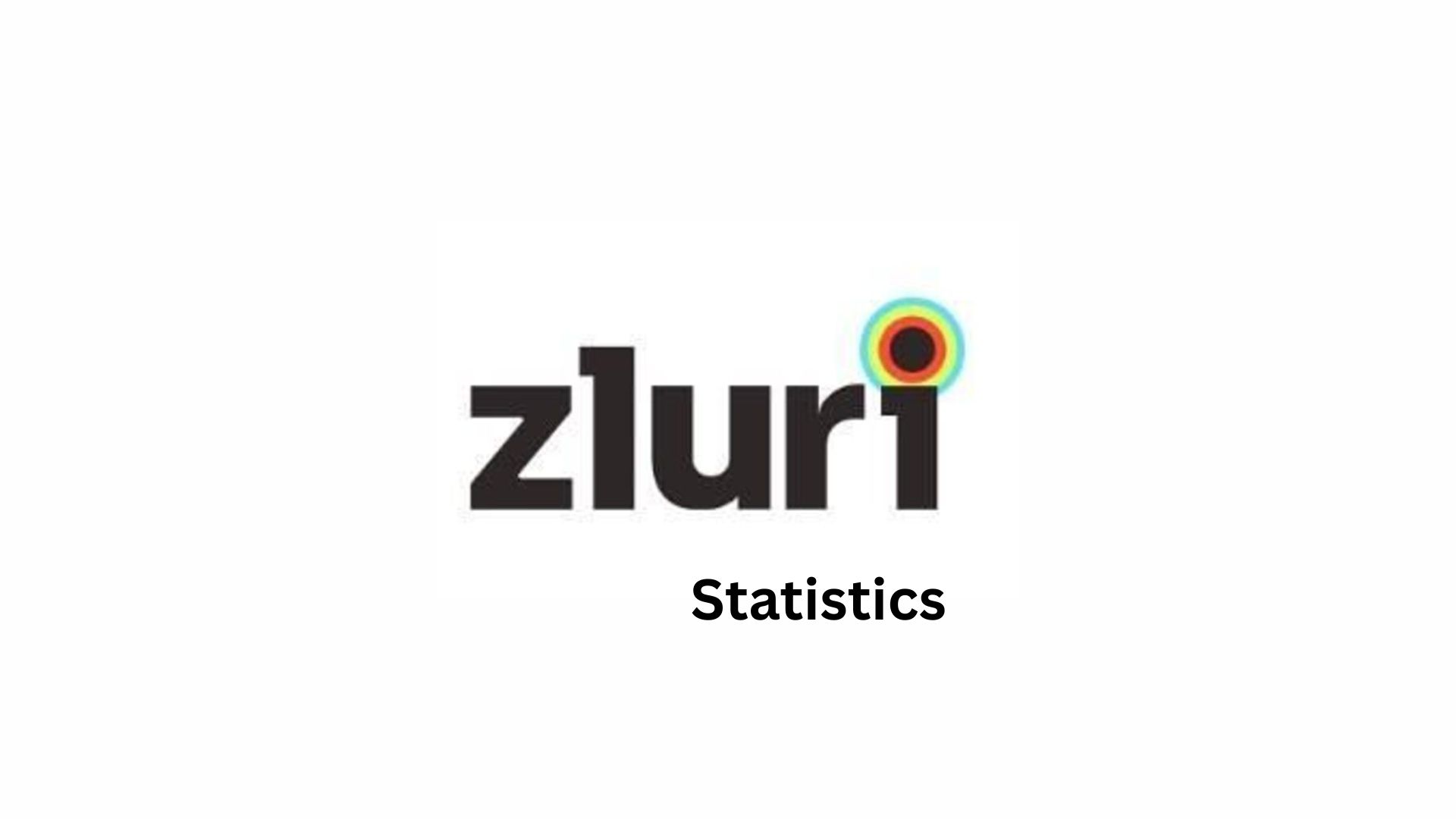Okta Statistics And Facts (2025)
Updated · Jul 02, 2025
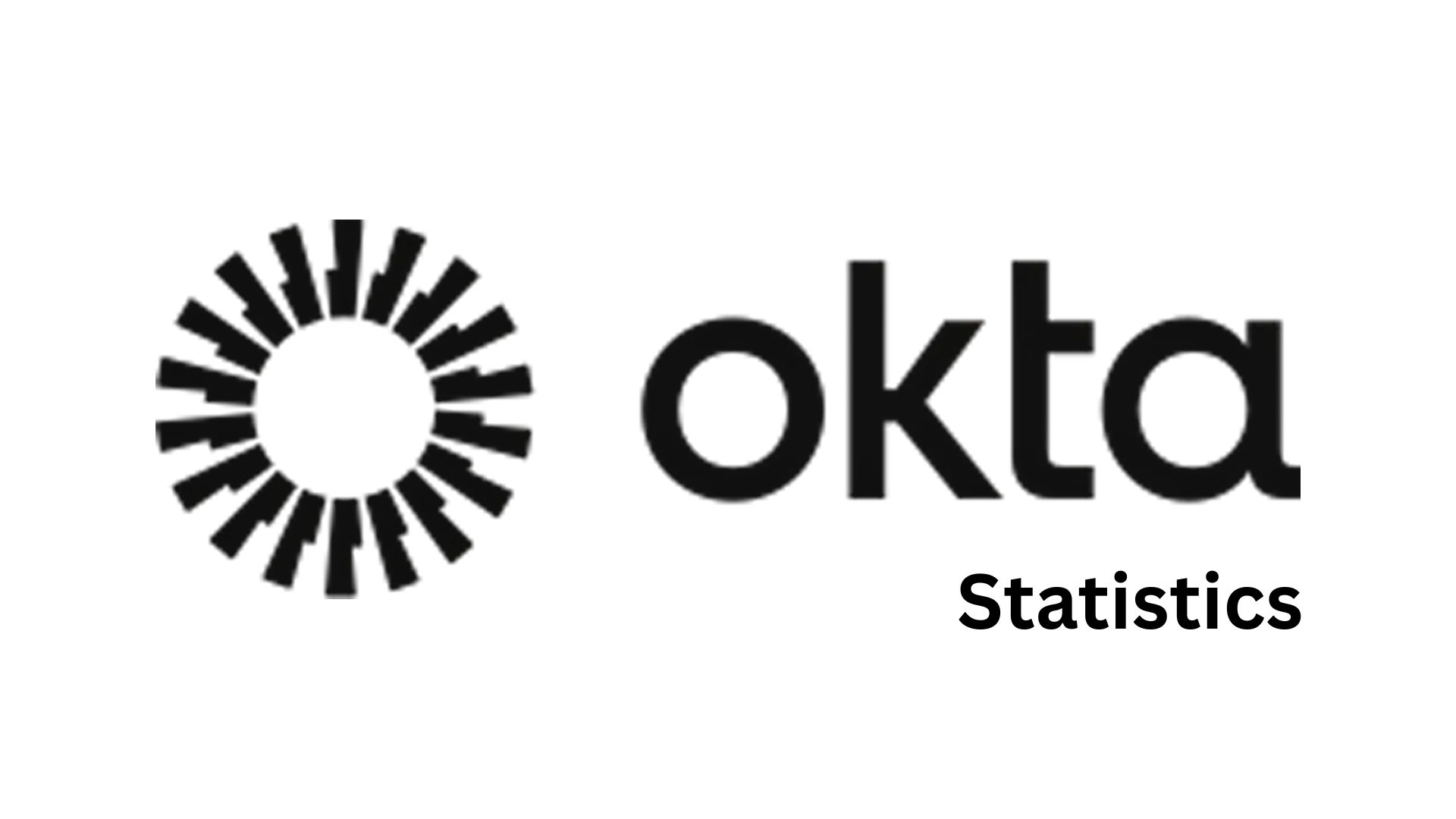
Table of Contents
Introduction
Okta Statistics: Okta, founded in 2009, is ranked among the world’s leading players in IDAM. Okta provides cloud software for computer application user authentication, management, and protection. In 2024, digital identity will be protected more than ever, and Okta will rise to stardom concurrently. Today, with thousands of enterprise clients and millions of users, Okta stands tall as one of the important players in the IDaaS sector.
This article will review key Okta statistics, including revenue, user base, market share, growth buoyancy, and issues.
Editor’s Choice
- Okta reached total revenues of US$2.61 billion in fiscal 2025, an increase of 15.3% from US$2.263 billion in 2024 and 21.8% since US$1.858 billion in 2023.
- Subscription services contributed 98% of revenue in 2025, amounting to US$2.556 billion.
- Professional services revenues decreased from US$64 million in 2023 to US$54 million in 2025.
- Cost of revenue grew to US$618 million in 2025, with subscription-related costs being the main driver.
- Operating expenses improved to US$2.066 billion in 2025 from US$2.198 billion in 2024, suggesting better cost controls.
- Sales and marketing expenses went down by 7% to US$965 million in 2025, which is 37% of total revenue compared to 46% in 2024.
- R&D expense dropped slightly to US$642 million in 2025 but was more efficient in terms of revenue (25% in 2025 vs. 29% in 2024).
- Cash flow from operations grew to US$750 million in 2025, an increase of US$238 million year-over-year.
- The workforce grew to 6,010 in 2023, reaching its pinnacle, and was probably optimised down to 5,910 in 2024.
- Shares of Okta issued at US$202 in 2021, fell to US$57 in 2023, and recovered to US$74 by 2025.
- The five-year performance of Okta was less than that of the S&P 500 Index (up to 203) and the S&P 500 Info Tech Index (up to 280).
- With revenue of US$2.916 billion for 2025, 110% of the target, and US$699.7 million in non-GAAP operating income, 120% of the target, Okta achieved its performance targets for FY2025.
- Bonus payments were made to eligible employees and executives at 120% of the target as a result of financial goal achievements.
Okta Revenue

(Source: s205.q4cdn.com)
- According to Okta’s statistics report, the platform’s financial performance over three fiscal years ended January 31, 2025, 2024, and 2023, with amounts in millions, begins with total revenue.
- Okta generated revenues of US$2,610 million in 2025, US$2,263 million in 2024, and US$1,858 million in 2023.
- It means sustained annual growth of about 15.3% in 2025 over 2024 and 21.8% over 2024 from 2023.
- Out of that, subscription sales accounted for most revenue: US$2,556 million in 2025, compared to US$2,205 million in 2024 and US$1,794 million in 2023.
- This source represented approximately 98% of the total revenue in 2025, establishing the dominance of Okta’s SaaS revenue path.
- Professional services and other revenues showed a decline from US$64 million in 2023 to US$58 million in 2024 and further down to US$54 million in 2025.
- There is a slight but steady decrease, which may be attributed to Okta’s focus on scalable, self-service solutions.
- The total cost of revenue, by way of comparison, was US$618 million in 2025, following US$581 million in 2024 and US$546 million in 2023.
- Subscription-related costs increased from US$464 million in 2023 to US$502 million in 2024 and US$549 million in 2025, paralleling the increasing subscription revenues and suggesting an intact gross margin profile.
- Professional services and other cost categories, however, were on the other side, going down from US$82 million in 2023 to US$79 million in 2024 and US$69 million in 2025, also tracking downward with the revenues in that segment.
- In conclusion, the Okta statistics indicate that Okta’s core subscription business is growing at a healthy clip, with costs well-controlled, particularly in areas that are considered lower priority, and will thus, over time, contribute to improved operational efficiency and profitability.
Okta Operating Expenses

(Source: s205.q4cdn.com)
- Okta statistics given by the company operating expenses report recorded total operating expenses of US$2,066 million for the year ended January 31, 2025, down from US$2,198 million in 2024 and US$2,124 million in 2023.
- Sales and marketing expenses were the largest component of operating expenses, amounting to US$965 million in 2025, down from US$1,036 million in 2024 and US$1,066 million in 2023, suggesting a more streamlined approach by Okta in acquiring and retaining customers.
- Research and development expenses were US$642 million in 2025, slightly less than US$656 million in 2024 but still exceeding the US$620 million registered in 2023, showing a steady commitment to innovation while maintaining some cost curtailment.
- General and administrative expenses were kept fairly constant at US$448 million in 2025, compared to US$450 million in 2024 and US$409 million in 2023, indicating a controlled increase in overheads. Restructuring and other charges witnessed a sharp decline in 2025 to US$11 million, from US$56 million in 2024 and US$29 million in 2023, indicating fewer organisational changes or the incurrence of one-time expenses this year.
- The year-over-year reduction in total operating expenses points towards a rise in operational efficiency and cost management.
Okta Research and Development

(Source: s205.q4cdn.com)
- Okta budgeted out US$642 million for R&D during the year ended January 31, 2025, versus US$656 million for the previous year.
- This resulted in US$14 million less spending, representing a 2% decrease. The slight decline in dollar amount may coincide with a shift in R&D spending vis-a-vis revenues: R&D in 2024 accounted for 29% of revenues, whereas it accounted for 25% in 2025.
- Thus, while Okta is still innovating heavily, its revenue growth has surpassed that of R&D expenditures, potentially implying either higher efficiency or a change in investment direction.
Okta Sales & Marketing Expenses

(Source: s205.q4cdn.com)
- In the fiscal year ended January 31, 2025, Okta spent US$965 million on sales and marketing expenses as compared to US$1.036 billion in the prior fiscal year (2024), which represents a US$71 million decrease, or 7%, in sales and marketing expenses year over year.
- From the total revenue standpoint, sales and marketing expenses in 2025 were 37% of revenues, whereas in 2024 these expenses were about 46% of revenues.
- The Okta statistics suggest that Okta became more efficient in sales and marketing expenses, which could be a result of improved customer acquisition strategy, an increase in brand recognition, or other cost-cutting measures, along with revenue growth.
Okta Cash Flows
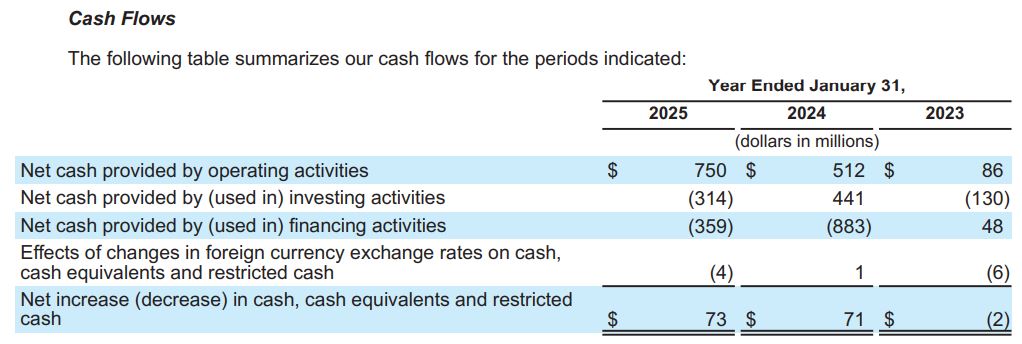
(Source: s205.q4cdn.com)
- Okta statistics state that the net cash flows of the company are generated from operating activities, investing activities, and financing activities.
- Okta’s cash flow activity in the fiscal year 2025 shows a remarkable change in the way the company handles its operational efficiency, investment strategy, and financing behaviour.
- In 2025, the company amassed US$750 million in cash from its operating activities, which was US$238 million more than the preceding fiscal year’s figure.
- This uptick in cash flow was primarily attributable to increased collections from customers and an efficient use of cash, thereby indicating a stronger operational performance and more robust financial discipline.
- Subscriptions and professional services principally brought this operating cash flow, while employee compensation, marketing expenses, and third-party hosting costs were potential uses. Investing activities consumed US$314 million in cash in 2025.
- This change is significant as the previous year saw US$441 million generated from investing activities. The shift arose from reduced proceeds from maturities and sales of available-for-sale securities, alongside increased payments for business acquisitions and purchases of new securities.
- These actions hint at the company strategically allocating resources to long-term growth and expansion opportunities.
- On the financing side, US$359 million in cash was used by Okta, which equates to US$524 million less than that in fiscal 2024.
- The year-on-year shrink primarily came about because of reduced repurchases of convertible notes. They were, however, partially offset by taxes to the net share settlement of equity awards.
- These reduced financing outflows point to a capital management style that is more stable and likely has less reliance on debt instruments or aggressive equity-related expenses.
Okta Total Number Of Employees
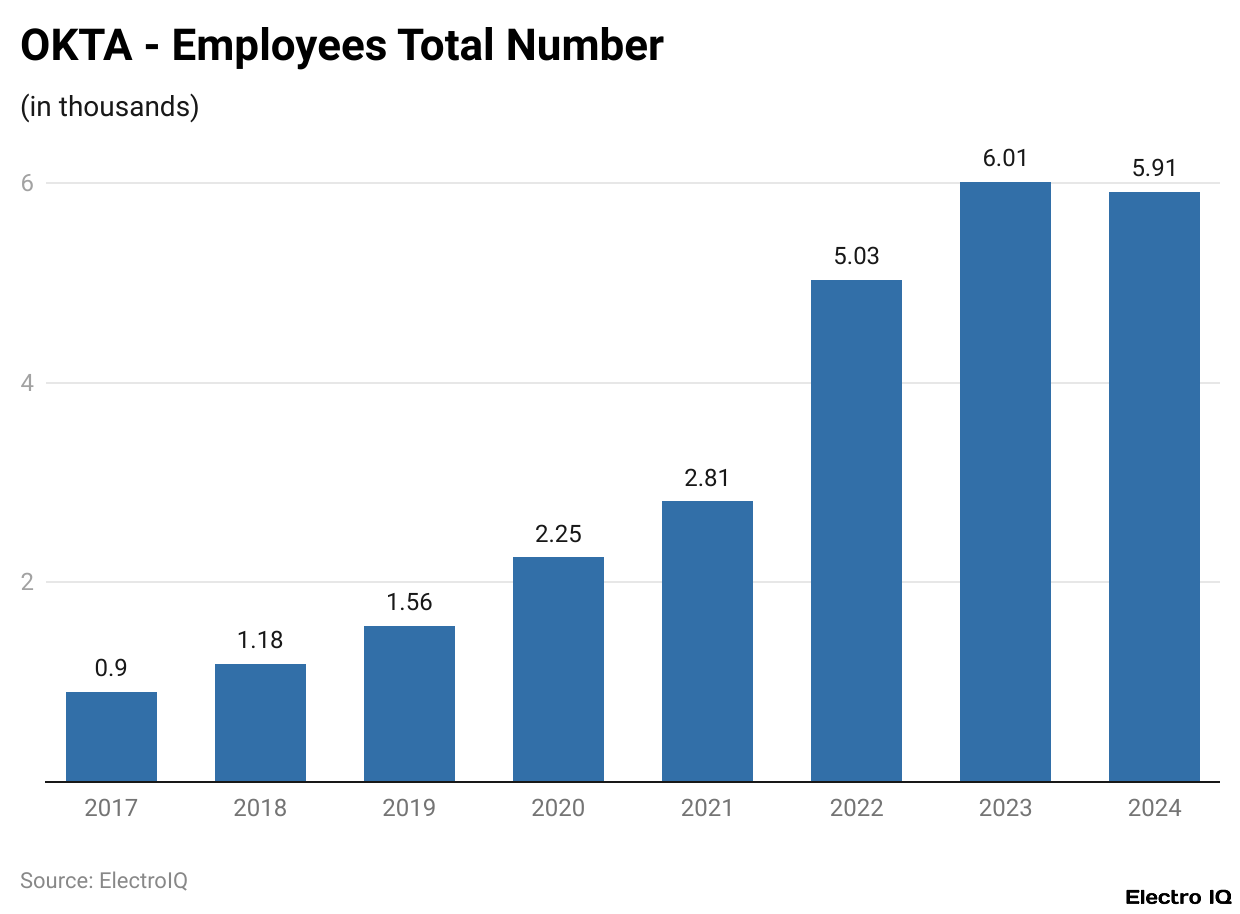
(Reference: tradingeconomics.com)
- According to the Trading Economics report on Okta statistics, the employee growth trends at Okta over the years demonstrate another important factor: the rapid expansion during the scale-up phase of the company, followed by some slight contraction in more recent times.
- The company classified 898 employees in 2017. Okta’s employee base increased steadily every year, counting approximately 1,180 in 2018, 1,560 in 2019, and 2,250 in 2020.
- The increase kept going until 2021, when it counted 2,810 employees. In 2022, the number skyrocketed, almost doubling from the hiring in 2021. By 2023, the workforce grew even further to 6,010 employees.
- However, in 2024, one could say that employee strength took a minor decline to 5,910 from 6,010.
- This casts some speculations that the dethronement was mainly due to some restructuring efforts, workforce optimisation at less than 10 employee reductions, or a reaction to broader market conditions following years of aggressive hiring.
- This downward trend indicates a stabilising phase of the company after years of very aggressive growth.
Okta Stock Performance
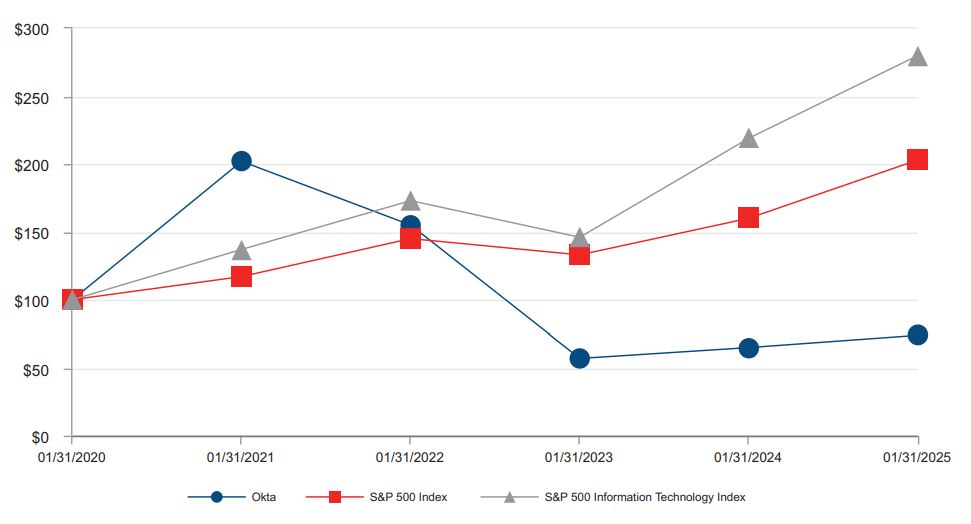
(Source: s205.q4cdn.com)
- Okta statistics state that from the five-year perspective spanning from January 31, 2020, to January 31, 2025, Okta’s stock performance has been starkly more volatile vis-à-vis broader market indices like the S&P 500 and the S&P 500 Information Technology Index.
- On January 31, 2020, the stock of Okta traded at US$100, and by the beginning of 2021, it had surged to US$202, more than doubling in value under heavy investor optimism during the pandemic-fueled digital transformation boom.
- Nonetheless, by 2022, the shares had receded to US$155, losing over 63% of their value from the 2021 peak, and took a nosedive to the worst price of US$57 in January 2023.
- Such a sharp decline was reflective of the larger challenges faced by the tech sector and the general fear concerning growth stocks.
- During the previous few years, Okta’s stock had a modest recovery, rising to US$65 in 2024 and US$74 in 2025; hence, this makes it clear that the stock is way below its 2021 highs, which may signal a cautious market outlook or growth being slower than expected.
- Comparatively, the S&P Index and the S&P 500 Information Technology Index have enjoyed stable growth all along.
- The S&P 500 rose from the base of 100 in 2020 to 203 in 2025, doubling more than in just five years. The tech-focused S&P 500 Information Technology Index did far better, climbing from 100 to 280 over the same period.
- This contrast suggests that while the general tech sector recouped well, Okta did not keep pace with its peers and may have done so due to some company-specific issues or a shift in investor sentiment.
Okta Fiscal Performance 2025

(Source: s205.q4cdn.com)
- Okta’s financial performance for 2025 was assessed against pre-established target levels for total revenue and non-GAAP operating income, with bonus payments being partially contingent on each metric and weighted accordingly- revenue was weighted at 60%, while operating income was weighted at 40%.
- The revenue target was US$2.65 billion, with the accompanying non-GAAP operating income target being US$583.1 million.
- Achievement of these targets would have resulted in a 100% target bonus for each metric.
- When talking about the threshold level, revenue of US$2.39 billion and operating income of US$466.5 million will achieve 80% and 60% of the target bonus, respectively.
- On the other hand, if the maximum is surpassed, i.e., revenue of US$2.916 billion and operating income of US$699.7 million, there will be a 120% payment on the target bonus concerning both metrics.
- The year Fiscal 2025 saw Okta’s achievements at the maximum levels for revenue and non-GAAP operating income.
- Actual revenue was recorded at US$2.916 billion, being 110% of the target, from which operating income came in at US$699.7 million, or 120% of the set target.
- Therefore, the Okta executives and employees who qualified for bonuses received compensation at 120% for both performance components, signifying strong financial execution that was beyond company expectations.
Conclusion
Okta statistics, performing well throughout 2024, have demonstrated the firm’s resiliency and innovative approach amidst rapid changes in the cybersecurity market. Okta is still building up as the main player in the identity and access management market. It is invested heavily in product development, go-to-market strategies, and ESG initiatives, all of which promote its status as a forward-thinking and trusted platform.
As organisations consider zero-trust architectures and secure remote access key aspects, Okta has long-term growth potential and future relevance in the digital identity ecosystem.
Sources
FAQ.
Okta registered US$2.61 billion in revenue during fiscal 2025, reflecting a growth of 15.3% from US$2.263 billion in 2024. Mostly, revenue growth was spurred by subscription services that alone accounted for 98% of total revenues, being billed at US$2.556 billion. The demand from enterprise customers for cloud-based identity and access management solutions acted as a growth catalyst.
Operating expenses dipped to US$2.066 billion in 2025 against a sum of US$2.198 billion in 2024. Most notable in reduction was that of sales and marketing expenses, hardened by a 7% decrease to US$965 million, a direct reflection of the productivity put into customer acquisition. Consequently, the company was in a position to improve operational efficiency and non-GAAP profitability, adjusting its financial performance targets upwards.
Having performed more than the fiscal 2025 financial targets, Okta posted a US$2.916 billion revenue (110% of the target) and a US$699.7 million non-GAAP operating income (120% of the target). This result allowed for 120% bonus payouts to eligible employees and executives, which indeed shows the practical execution of the company.
The stock of Okta has been very volatile; it peaked at US$202 in 2021 before falling drastically to US$57 in 2023, slowly recovering to US$74 in 2025. Meanwhile, while the S&P 500 Index rose to 203 and the S&P 500 Information Technology Index hit 280, Okta, therefore, has badly underperformed the broader tech sector.
Okta saw a slight decline in headcount, from 6,010 in 2023 to 5,910 in 2024, which implies some optimisation in human resources. As that was going on, cash flow from operating activities increased from US$542 million in 2023 to US$750 million in 2024, while cash used in financing activities decreased from US$924 million to US$400 million, giving evidence of efficiency in capital allocation on the company’s part.

Tajammul Pangarkar is the co-founder of a PR firm and the Chief Technology Officer at Prudour Research Firm. With a Bachelor of Engineering in Information Technology from Shivaji University, Tajammul brings over ten years of expertise in digital marketing to his roles. He excels at gathering and analyzing data, producing detailed statistics on various trending topics that help shape industry perspectives. Tajammul's deep-seated experience in mobile technology and industry research often shines through in his insightful analyses. He is keen on decoding tech trends, examining mobile applications, and enhancing general tech awareness. His writings frequently appear in numerous industry-specific magazines and forums, where he shares his knowledge and insights. When he's not immersed in technology, Tajammul enjoys playing table tennis. This hobby provides him with a refreshing break and allows him to engage in something he loves outside of his professional life. Whether he's analyzing data or serving a fast ball, Tajammul demonstrates dedication and passion in every endeavor.




